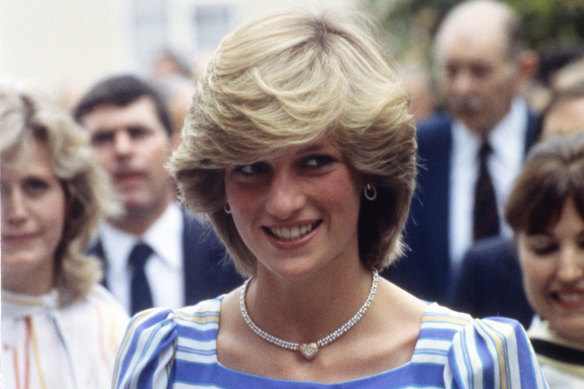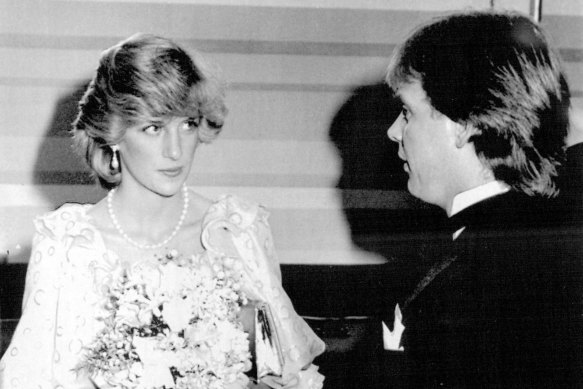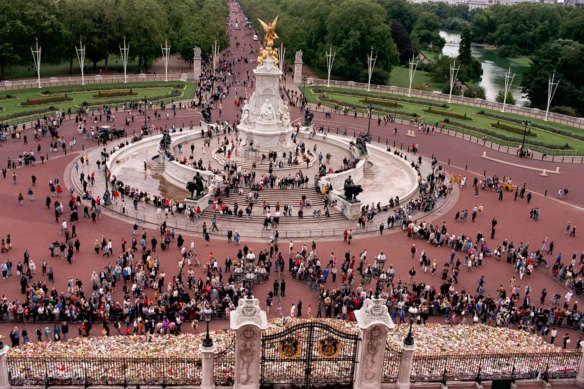First published in The Age on September 1, 1997
Britain mourns as tributes pour in
London, Sunday
Britain and the world were in mourning today, shocked by the death of Diana, Princess of Wales, from injuries she sustained in a car crash in a tunnel by the River Seine in Paris.
Princess of Wales, smiles during her visit to the Elmhurst Ballet School, in Camberley, Surrey.Credit:AP
The world’s most photographed woman and divorced wife of the heir of the British throne, died in a crash early this morning that also claimed her millionaire companion, Mr Dodi al-Fayed, when their driver lost control at high speed and hit a concrete pillar.
French surgeons at the Pitie-Salpetriere Hospital battled for hours to save the 36-year-old Princess, cutting open her shattered chest, sewing up a ruptured vein and massaging the heart in an effort to make it pump.
Three-and-a-half hours after the crash they conceded defeat and Diana, campaigner against land mines, the woman who wanted to be the “Queen of People’s Hearts”, died at 4 am.
The accident happened at 12.35am today, in a motorway underpass beneath the Place de l’Alma, on the banks of the Seine close to the Eiffel Tower. The Princess and Mr Fayed had been dining at the Ritz Hotel, which is owned by Mr Fayed’s father. They left by a back entrance to avoid the paparazzi, but were spotted and pursued.
“The car was being chased by photographers on motorcycles,” a spokesman for the Paris police said.
French detectives detained seven press photographers and other witnesses for questioning. Six of the freelance photographers were French nationals and the seventh a Macedonian.
Interior Minister Jean-Pierre Chevenement said Diana’s driver was thought to have lost control of his car while being pursued by the paparazzi.
Princess Diana with John Farnham at the Melbourne Concert Hall in 1983.Credit:THe Age Archives
The front of the car folded like an accordion, its bumper driven back almost to the windscreen. Mr Fayed died on the spot.
The driver of the blue Mercedes, a Ritz security officer, was also killed. The fourth person in the car, one of the Princess’s bodyguards, was injured and freed from the wreck by rescue workers who cut the roof open.
The Queen and Prince Charles were said to be deeply shocked and distressed. Charles, in Scotland, broke the news to their sons, Princes William, 15, and Harry, 12.
Tributes to the Princess poured in from all over the world from political leaders and leaders of church, charitable and other organisations which had benefited from her high-profile support.
London took on the air of a city in mourning as people began from about 5am bringing spontaneous tributes of flowers, candles and messages to place at the gates of Buckingham Palace and Kensington Palace, the Princess’s London home.
Many were weeping and some prayed as they placed their offerings, pausing a moment before going on their way.
By 10am church bells were tolling, and a crowd of several hundred mourners had gathered outside Buckingham Palace, where police had erected metal barriers in expectation of greater crowds.
Crowds leave their floral tributes at the gates of Buckingham Palace.Credit:AP
The Prime Minister, Mr Tony Blair, said he was “utterly devastated”. “The whole of our country will be in a state of shock and mourning,” Mr Blair said.
The French President, Jacques Chirac, paid tribute to the Princess as “a young woman of our age, warm, full of life and generosity”.
President Clinton said he and his wife, Hillary, who recently entertained the Princess on her visit to Washington, were “profoundly saddened by this tragic event.”
Mr Fayed’s father, Mohamed al-Fayed, the owner of Harrods, also flew to Paris from London in his helicopter yesterday. He issued a statement in which he described the deaths as “appalling and needless”.
“The world has lost a Princess who is simply irreplaceable,” the statement said.
First published in The Age on September 1, 1997
Diana Comes Home
London, Sunday
THE BODY of Diana, Princess of Wales, was brought home to Britain today. Eight Royal Air Force pallbearers slowly lifted her coffin, draped in the Royal Standard flag, out of the plane that had carried it from Paris to the Northolt military airbase, north-west of London.
Diana’s former husband, Prince Charles, and her two sisters, Lady Jane Fellowes and Lady Sarah McCorquodale, who had flown back with the body, stood silently alongside the British Prime Minister, Tony Blair, and a handful of other dignitaries.
No music was played and no prayers or words of tribute were recited as the coffin was taken to a glass-pannelled black hearse for its journey to a private mortuary in London.
Buckingham Palace is not expected to announce funeral details until tomorrow, after discussions with the government and Diana’s family.
The 36-year-old princess died in a car crash in Paris with her companion, Dodi al-Fayed.
Mr Fayed was buried in Woking, a southern English town, this evening.
As Diana’s coffin was unloaded from the plane, Mr Blair looked distraught and barely able to control his emotions. Prince Charles was serious but composed, and fiddled nervously with his cufflinks during the coffin’s slow procession from plane to hearse.
He left soon afterwards for Scotland, where he will rejoin his two sons, William and Harry, at the royal family’s rural Balmoral retreat. There will be immense pressure from the public for Diana to be honoured in style but, despite her fame and prominence, protocol makes it unlikely that she will be granted a state funeral.
But as the mother of a future king, Prince William, her place in public life was secured and Charles’ decision to fly to Paris to accompany the coffin back home was a key indicator of her official standing.
The future public standing of the royal family, damaged by divorce and scandal, could well hinge on whether Britons feel it treated Diana properly in death.
At St Paul’s Cathedral tonight, grief and tears gave way to tranquillity and calm as about 2000 people gathered to remember Princess Diana in the church where she was married in a glittering royal ceremony 16 years ago.
British broadcasting networks dropped regular programs to bring constant news coverage of the tragedy.
News bulletins were preceded by the national anthem, newsreaders wore black ties and soccer matches were cancelled.
Earlier at Balmoral, three black limousines crawled up the hill to the Crathie church at 11.30am. In the first were the Queen and Prince Philip, followed by a Daimler carrying Prince Charles and his sons, then the Queen Mother and other members of the royal family in the third.
The Queen was wearing a knee-length coat and simple hat, both in Presbyterian black. Prince Charles, in full highland regalia, wore a black tie, as did Princes William and Harry. The other family members present, Prince Andrew and Peter Phillips, sombrely and slowly helped the Queen Mother into the church.
As always, the Queen stopped by the side door for a brief conversation with the royal chaplain, the Reverend Robert Sloan. Prince William stole a quick glance over his shoulder at the watching crowd. Prince Harry stared at the ground.
Most Viewed in World
From our partners
Source: Read Full Article


